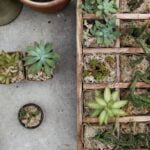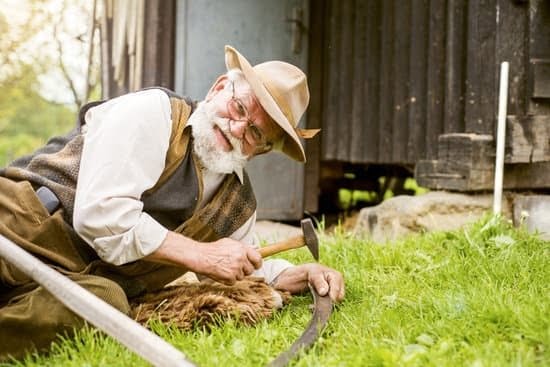Are you looking for creative and sustainable ways to spruce up your garden? Look no further than gardening ideas for tree stumps. Tree stumps can offer a unique and charming addition to your outdoor space, adding a touch of rustic elegance while also contributing to environmentally-friendly landscaping practices.
When it comes to selecting the right tree stump for your garden, there are several factors to consider. Not only do tree stumps provide an opportunity for creative planting ideas, but they can also be repurposed into garden furniture and decorations. With the right care and maintenance, these repurposed stumps can become vibrant focal points in your garden design.
In this article, we will explore the versatility and potential of using tree stumps in gardening and landscaping. From creative planting ideas to DIY projects, we will discuss various ways to incorporate tree stumps into your outdoor space. Learn how repurposing tree stumps can not only enhance the aesthetic appeal of your garden but also contribute to sustainable landscaping practices. So, let’s dive into the beauty of repurposing tree stumps in your garden.
Choosing the Right Tree Stump
When it comes to choosing the right tree stump for your gardening project, there are a few important factors to consider. The first consideration is the size and shape of the stump.
Look for a stump with a flat or slightly concave top surface, as this will make it easier to plant and maintain your garden on top of it. Additionally, consider the height of the stump in relation to the surrounding plants and landscape features, as well as its overall stability.
Tree Species
Another important factor to consider when selecting a tree stump for gardening is the species of tree it came from. Certain types of wood, such as cedar or redwood, are more resistant to decay and will last longer as a planter. You’ll also want to consider any potential issues with toxic substances that may be present in certain tree species.
Location
The location of the tree stump within your garden should also play a role in your decision-making process. Think about how much sunlight the area receives and whether the stump will be exposed to excessive moisture or dryness. These environmental factors can impact the success of your gardening project on the tree stump.
Lastly, assess any existing damage or decay in the tree stump before repurposing it for gardening. If there are signs of rot or instability, you may need to reconsider using that particular stump for your planting ideas. By considering these factors carefully, you can ensure that you choose a suitable tree stump for your gardening project, setting yourself up for success with this unique landscaping feature.
Creative Planting Ideas
Tree stumps are often seen as an eyesore in the garden, but with some creativity and ingenuity, they can be transformed into unique and eye-catching planters. With the right approach, these tree stumps can become a beautiful addition to your garden, adding character and charm to your outdoor space.
One of the first steps in repurposing a tree stump into a planter is to consider its size and shape. The natural nooks and crannies of a tree stump can create an interesting and visually appealing setting for plants.
Depending on the size of the tree stump, you can use it to plant a variety of flowers, herbs, or even small shrubs. By choosing plants that complement the overall aesthetic of your garden, you can turn an old tree stump into a striking focal point.
When filling a tree stump planter, it’s important to use well-draining soil and consider the specific sunlight and water needs of the plants you choose. The hollowed-out center of a tree stump provides an ideal environment for certain types of plants that thrive in well-drained conditions. Additionally, using a mix of different plant heights and colors can create visual interest within the planter.
Incorporating various textures such as moss or rocks into the design can elevate the visual appeal of your tree stump planter. You can also adorn the outer edges with decorative elements like pebbles or tiles to add personality and style to your creation.
By taking these factors into consideration, you can transform any tree stump into a stunning planter that adds beauty and functionality to your garden space. With these gardening ideas for tree stumps, you’ll be able to create truly unique and eye-catching displays in your outdoor area.
| Tree Stump Planter Design Element | Description |
|---|---|
| Plant Selection | Choose plants that complement the overall aesthetic of your garden. |
| Drainage | Use well-draining soil and consider sunlight/water needs of selected plants. |
| Decorative Elements | Incorporate textures such as moss or rocks along with decorative elements like pebbles or tiles. |
Maintenance Tips
Maintaining tree stumps in your garden can be a key factor in ensuring that they remain healthy and vibrant additions to your landscaping. Proper care and maintenance can also help prevent them from becoming eyesores or hazards. Here are some essential tips for maintaining your garden tree stumps:
Regular Inspections and Pruning
Regular inspections of your tree stumps are essential for identifying any signs of decay, disease, or pest infestations. Keep an eye out for any abnormal growth or discoloration on the stump and surrounding areas. Additionally, pruning any new shoots that may sprout from the stump can help maintain its shape and prevent overcrowding.
Watering and Fertilizing
Even though the tree may have been removed, the stump still requires adequate water to stay healthy. Depending on the climate and location, watering the tree stump regularly will ensure that it doesn’t dry out. Additionally, applying a balanced fertilizer around the base of the stump can provide essential nutrients for healthy growth.
Protecting Against Decay
To prevent decay, consider applying a protective coating or sealant to the surface of the stump. This will help safeguard it against moisture and fungal infestations, ultimately prolonging its lifespan.
By following these maintenance tips, you can ensure that your garden tree stumps remain a vibrant and integral part of your landscaping. With proper care, they can continue to enhance the aesthetic appeal of your garden while providing an eco-friendly and sustainable gardening solution for repurposing tree stumps in creative ways.
These gardening ideas for tree stumps not only contribute to enhancing the visual appeal of your outdoor space but also promote environmental sustainability through recycling and repurposing natural materials.
Incorporating Tree Stumps Into Landscaping
When it comes to incorporating tree stumps into your garden landscaping, there are various creative and practical ways to make them focal points of your outdoor space. One popular method is to turn tree stumps into natural pedestals for decorative elements such as bird baths, sculptures, or even outdoor lighting fixtures. By strategically placing these items on sturdy and stable tree stumps, you can instantly elevate the visual appeal of your garden while also adding a touch of whimsy.
Another gardening idea for tree stumps is to transform them into charming seating areas. A large, flat tree stump can be used as a rustic bench or stool, providing a unique and organic seating option for your outdoor space.
You can further enhance the comfort and style by adding weather-resistant cushions or covering the stump with a colorful mosaic design. This not only adds functionality to the tree stump but also creates an inviting nook within your garden where you can relax and appreciate the natural surroundings.
Furthermore, using tree stumps as natural plant stands is another innovative way to incorporate them into your garden design. Placing potted plants or small shrubs on top of sturdy tree stumps adds dimension and visual interest to the landscape.
Additionally, this approach allows for better air circulation around the plants and helps keep them off the ground, reducing the risk of waterlogging and pests. As a result, each tree stump becomes a mini elevated garden bed, showcasing your favorite greenery while adding an element of charm and creativity to the overall aesthetic.
| Gardening Ideas | Tree Stump Utilization |
|---|---|
| Bird baths | Decorative pedestals |
| Rustic bench or stool | Seating areas |
| Plant stands | Elevated garden beds |
DIY Projects
Tree stumps can be repurposed into unique and functional pieces of garden furniture and decorations, adding a rustic charm to your outdoor space. With a little creativity and the right tools, you can transform tree stumps into beautiful and useful items for your garden. Here are some DIY projects to consider:
Garden Benches
One popular project is turning a large tree stump into a garden bench. By adding a simple wooden or metal seat, you can create a sturdy and natural-looking seating area for your garden. This not only adds character to your outdoor space but also provides a cozy spot to relax and enjoy the beauty of your garden.
Side Tables
Smaller tree stumps can be repurposed into charming side tables for your patio or outdoor seating area. Simply add a flat wooden or glass top to the stump to create a stylish and functional table. You can even customize the height and size of the table to fit your specific needs.
Decorative Planters
Hollowed-out tree stumps make excellent planters for flowers, herbs, or succulents. You can carve out the center of the stump and fill it with soil, creating a unique and eye-catching planting area for your favorite greenery. These natural planters add an interesting focal point to your garden while also showcasing the beauty of nature.
By implementing these gardening ideas for tree stumps, you can elevate the aesthetic appeal of your outdoor space while making use of sustainable materials. Whether you opt for functional furniture pieces or decorative accents, repurposing tree stumps is a creative way to enhance your garden’s beauty while reducing waste in an environmentally friendly manner.
Environmental Benefits
When it comes to gardening, tree stumps are often seen as eyesores that need to be removed. However, repurposing tree stumps in your garden can actually contribute to sustainable landscaping practices and provide a range of environmental benefits. By finding creative ways to incorporate tree stumps into your garden design, you can reduce waste, promote biodiversity, and create a more environmentally friendly outdoor space.
One of the key environmental benefits of gardening with tree stumps is their ability to provide habitat for various forms of wildlife. When left in place or repurposed as planters or decorative elements, tree stumps can attract insects, birds, and small mammals. This contributes to the overall biodiversity of your garden and supports local ecosystems. In addition, the decaying wood of tree stumps provides food and nesting sites for different species, further enhancing the ecological value of your outdoor space.
Furthermore, utilizing tree stumps in your garden can also help reduce waste and promote sustainability. Rather than disposing of tree stumps after they have been removed from your property, repurposing them as planters or incorporating them into garden furniture reduces the demand for new materials.
This promotes a more circular approach to landscaping and reduces the environmental impact associated with manufacturing and transporting new garden products. Embracing gardening ideas for tree stumps not only adds visual interest to your outdoor space but also aligns with a more sustainable approach to landscaping.
- Provide habitat for various forms of wildlife
- Promote biodiversity in your garden
- Reduces waste by repurposing materials
- Supports a more sustainable approach to landscaping
Conclusion
In conclusion, tree stumps offer endless possibilities for creative and unique gardening and landscaping projects. Whether you choose to repurpose them as planters, focal points in your garden design, or even transform them into DIY furniture and decorations, tree stumps can add a touch of natural beauty to any outdoor space. The environmental benefits of using tree stumps in gardening should not be overlooked, as they contribute to sustainable landscaping practices by repurposing natural materials.
When selecting a tree stump for gardening, it’s important to consider factors such as the size, shape, and condition of the stump. By carefully choosing the right stump, you can ensure that your gardening projects will thrive and enhance the overall aesthetic of your outdoor space. With proper maintenance and care, garden tree stumps can continue to bring life and character to your garden for years to come.
If you’re looking for gardening ideas for tree stumps that go beyond traditional planting methods, consider incorporating them into landscaping or creating unique DIY projects. By thinking outside the box and getting creative with how you use tree stumps in your garden, you can elevate the visual appeal of your outdoor space while also contributing to environmentally-friendly practices.
Whether you’re a seasoned gardener or just starting out, there are endless opportunities to explore the versatility and potential of tree stumps in gardening and landscaping.
Frequently Asked Questions
What Can You Grow on Tree Stumps?
Tree stumps can be repurposed as planters for flowers, herbs, or small bushes. By hollowing out the top of the tree stump and filling it with soil, you can create a unique and natural-looking garden feature.
How Do You Make a Garden Around a Tree Stump?
To make a garden around a tree stump, you can utilize the space by adding potted plants or small shrubs around the base of the stump. This can provide a visual distraction from the stump itself and create an attractive garden area.
What Can I Do With Tree Stumps in My Yard?
Tree stumps in your yard can serve multiple purposes. They can be turned into outdoor seating by adding cushions or used as decorative elements in your garden. Alternatively, they can be ground down to below-ground level to allow for easier landscaping and mowing.

Welcome to my gardening blog! I am passionate about plants and enjoy sharing my knowledge and experiences with others. In this blog, I will write about everything related to gardening, from tips on how to get started to updates on my own garden projects.





